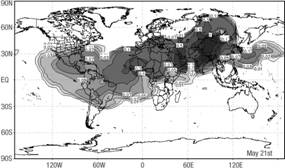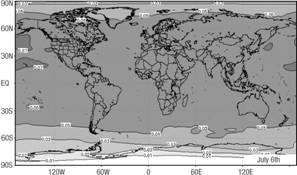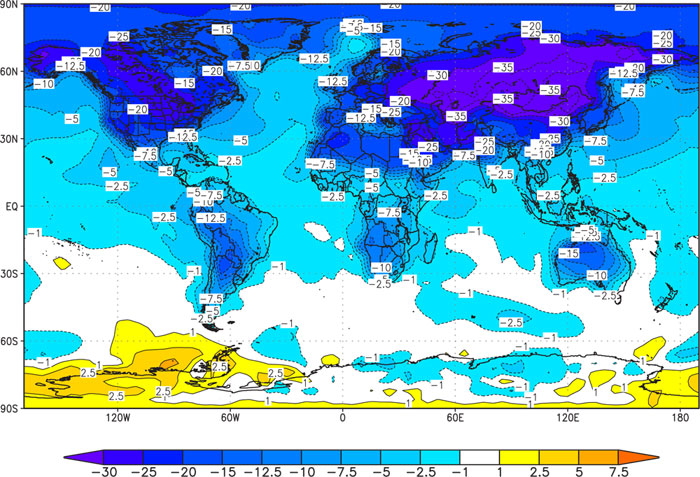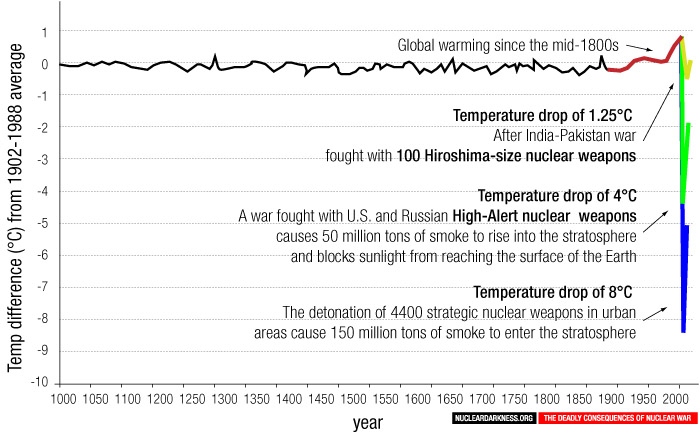Steven Starr, PSR, University of Missouri
Abstract
A tiny fraction of the operational nuclear arsenals, if detonated within large cities, would generate enough smoke to cause catastrophic disruptions of the global climate[1]and massive destruction of the protective stratospheric ozone layer.[2] Environmental devastation caused by a war fought with many thousands of strategic nuclear weapons would quickly leave the Earth uninhabitable.[3]
Deadly Climate Change and Massive Ozone Destruction from Nuclear War
Nuclear detonations within urban and industrial areas would ignite immense firestorms which would burn everything imaginable and create millions of tons of thick, black smoke. Much of this smoke would rapidly be lofted above cloud level, into the stratosphere, where it would block warming sunlight from reaching the lower atmosphere and surface of the Earth. Sunlight would then markedly heat the upper atmosphere and cause massive destruction of the protective ozone layer, while darkness below would produce average surface temperatures on Earth characteristic of those experienced during an Ice Age.
The darkness and global cooling predicted to result from nuclear war (along with massive radioactive fallout, pyrotoxins, and ozone depletion) was first described in 1983 as “nuclear winter”.[4] These initial studies estimated the smoke from nuclear firestorms would stay in the stratosphere for about a year. However in 2006, researchers using modern computer models found the smoke would form a global stratospheric smoke layer that would last for ten years.[5]
The longevity of such a smoke layer would allow much smaller quantities of smoke than first predicted in the 1980’s to have a great impact upon both global climate and atmospheric ozone which blocks ultraviolet (UV) light. Thus scientists predict that even a “regional” nuclear conflict could produce enough smoke to significantly cool average global surface temperatures, reduce precipitation, and vastly increase the amount of dangerous UV light reaching the surface of Earth.
In other words, a nuclear war fought between such nations as India and Pakistan would produce enough smoke to make the blue skies of Earth appear grey. Although the amount of sunlight blocked by this smoke would not produce the profound darkening of the Earth predicted in a nuclear winter (following a nuclear war fought with thousands of strategic nuclear weapons), the deadly climate change created by the regional conflict would likely have devastating global effects upon all human populations through its negative influence upon agriculture.[6]
Nuclear War Fought with Hiroshima-size (15 kiloton) Low-Yield Nuclear Weapons
In 2006, U.S. researchers used a NASA computer model (Model 1E, also used for the Intergovernmental Panel on Climate Change to predict global warming) to evaluate the effects of a regional nuclear war fought in the sub-tropics.[7] 50 Hiroshima-size nuclear weapons (15 kilotons per weapon) were detonated in the largest cities of each combatant nation (100 total detonations).
The studies predicted the nuclear explosions would kill 20 million people in the war zone, the equivalent to half of all the people who died during World War II. The conflict would also significantly disrupt global climate. Up to 5 million tons of smoke from burning cities would quickly rise above cloud level into the stratosphere, and within 2 weeks would form a global stratospheric smoke layer which would remain in place for about 10 years.[8]
The computer models estimated this smoke layer would block 7–10% of warming sunlight from reaching the surface of the Earth. Average surface temperatures beneath the smoke would become colder than any experienced during the last 1000 years. There would be a corresponding shortening of growing seasons by up to 30 days and significant reductions in average rainfall in many areas, with a 40% decrease of precipitation in the Asian monsoon region.[9]
Such rapid and drastic climate change would have major impacts on global grain reserves, which already are at 50 year lows.9 Grain exports would likely cease for several years from large exporting nations like Canada.[10] The 700 million people now living on the edge of starvation, along with those populations heavily dependent upon grain imports, would face mass starvation as grain reserves disappeared, prices skyrocketed and hoarding occurred. Global nuclear famine is the predicted result of this scenario. As many as one billion people could die during the years subsequent to the deadly climate change created by this level of nuclear conflict.[11]
Stratospheric Ozone Destruction and Increased Levels of Harmful Ultraviolet (UV-B) Light
A stratospheric smoke layer would also cause massive destruction of the protective ozone layer. Studies in 2008 predicted smoke from a regional nuclear conflict (as described above) would create ozone losses of 25-45% above mid latitudes, and 50-70% above northern high latitudes persisting for 5 years, with substantial losses continuing for 5 additional years.[12] Severe ozone depletion would allow intense levels of harmful ultraviolet light (UV-B) to reach the surface of the Earth – even with the stratospheric smoke layer in place.
Regional Nuclear War between and Pakistan
100 Hiroshima-size (15 kiloton) nuclear weapons detonated in urban areas

Smoke from burning cities enters stratosphere
100 nuclear explosions create massive firestorms in the cities of India and Pakistan. 5 million tons of smoke rises above cloud level into the stratosphere and forms a global smoke layer which will remain in place for 10 years. The smoke layer will block 10% of sunlight from reaching the surface of the Earth.

Global smoke layer forms
Loss of warming sunlight creates the coldest average surface temperatures on Earth in the last 1000 years. Prolonged cold acts to reduce average precipitation by 40% to 50% in some areas. Sunlight heats the smoke in the stratosphere; the hot smoke destroys 25% to 45% of the protective ozone layer above the populated mid-latitudes and 50% to 70% of the ozone above the northerly latitudes, allowing massive amounts of harmful UV light to reach marine and terrestrial ecosystems.

10% of sunlight blocked from reaching the surface of Earth
The combined decreases in average temperature, precipitation, sunlight and stratospheric ozone would act to significantly shorten growing seasons and reduce agricultural production for several years. Conditions would then slowly return to normal over a period of about a decade. Given that world grain reserves are now only adequate to sustain human populations for about 30 to 50 days, it is likely that prolonged and severe food shortages will result from such drastic changes in global climate. Those human populations already living at the verge of starvation and dependent upon imported food supplies will be at extreme risk of famine and starvation if grain exports from North America and Eurasia are suddenly halted by Ice Age weather conditions. It has been estimated that up to 1 billion people could starve to death following this regional nuclear conflict.
Credits: The smoke images were created by Dr. Luke Oman of Rutgers University and are reproduced with his permission. The data on deadly climate change from regional nuclear conflict is taken from “Climatic consequences of regional nuclear conflicts”, by Robock A., Oman L., Stenchikov G., Toon O. B., Bardeen C., and Turco R., Atmospheric Chemistry and Physics, Vol. 7, 2007, p. 2003-2012; the data on ozone depletion is from “Massive global ozone loss predicted following regional nuclear conflict”, by Mills M, Toon O, Turco R, Kinnison D, Garcia R (2008). Proceedings of the National Academy of Sciences (USA), Apr 8, vol. 105(14), pp. 5307-12; data on famine, I. Helfand, An Assessment of the Extent of Projected Global Famine Resulting From Limited, Regional Nuclear War, 2007, International Physicians for the Prevention of Nuclear War, Physicians for Social Responsibility, Leeds, MA
Global stratospheric ozone levels would fall to near those now seen only over Antarctica during the formation of the “ozone hole”. The UV index in the mid-latitudes would increase by 42–108%, which would cause fair skinned people to suffer sunburn in as little as 7 minutes. In the high northerly latitudes, the UV index would increase by 130–290%, shortening the time required for fair skinned people to sunburn from 32–43 minutes to 8–19 minutes.[13]
Massive increases of UV-B light would clearly have negative impacts upon marine and terrestrial ecosystems, yet no research is being done to investigate the consequences of such a scenario. Likewise, no studies using modern climate models have yet been done to assess ozone depletion following larger nuclear conflicts fought with high-yield strategic nuclear weapons.
Nuclear War Fought with High-Yield Strategic Nuclear Weapons[14]
The high-yield strategic nuclear weapons in the operational arsenals of the U.S. and Russia have a combined explosive power at least 500 times greater than the low-yield weapons detonated in the regional war conflict. A large fraction of these strategic weapons are kept on high-alert status (in 2009, more than 2000 U.S. and Russian strategic warheads were on high-alert).[15] Virtually all their land-based intercontinental ballistic missiles are kept ready to launch within 30 seconds to 3 minutes, apparently operating under the policy of Launch-On-Warning.[16]
In 2008, scientists predicted the detonation of 4400 strategic nuclear weapons in large cities could cause 770 million prompt fatalities and produce up to 180 million tons of thick, black smoke.[17] Ten days after detonation, the smoke would form a dense global stratospheric smoke layer which would block about 70% of warming sunlight from reaching the surface of the Northern Hemisphere and 35% of sunlight from reaching the Southern Hemisphere.[18]
The resulting nuclear darkness would cause rapid cooling of more than 20º C (36º F) over large areas of North America and of more than 30º C (54º F) over much of Eurasia (Figure 2). Daily minimum temperatures would fall below freezing in the largest agricultural areas of the Northern Hemisphere for a period of between one to three years. Average global surface temperatures would become colder than those experienced 18,000 years ago at the height of the last Ice Age.[19]
The cooling of the Earth’s surface would weaken the global hydrological cycle and the Northern Hemisphere summer monsoon circulations would collapse because the temperature differences that drive them would not develop. As a result, average global precipitation is predicted to decrease by 45%.[20]
The cumulative effects of deadly climate change and ozone destruction would eliminate growing seasons for more than a decade. Catastrophic climatic effects lasting for many years would occur in regions far removed from the target areas or the countries involved in the conflict.[21] Under such conditions, it is likely that most humans and large animal populations would die of starvation.[22]

Global Warming versus GlobalCooling from Nuclear War

Conclusions
The scientific studies summarized in this paper make it clear that the environmental consequences of a “regional” nuclear conflict could kill hundreds of millions of people far from the war zone. Deadly climate change caused by a war fought with the strategic nuclear arsenals of the U.S. and Russia would threaten the continued survival of the human species.
Yet neither the U.S., nor Russia, nor any other nuclear weapons state has ever officially evaluated what effects a war fought with their nuclear arsenals would have upon the Earth’s climate and ecosystems.[25] Surely it is time for such evaluations to be openly conducted and made subject to public discussion. Nations with nuclear weapons should be required to create Environmental Impact Statements on the likely results of the detonation of their arsenals in conflict.
Deadly climate change from nuclear war must become a primary topic in the debate about the need for “a world without nuclear weapons”. This discussion must include the dangers posed by the nuclear arsenals of all nations, including those in the U.S. and Russia. A failure to recognize and describe the omnicidal potential of strategic nuclear arsenals will prevent the abolition discussion from developing the sense of urgency needed to bring about fundamental change in the nuclear status quo.
The nuclear weapons which are kept ready for virtually instant use constitute a well-maintained self-destruct mechanism for the human race. What political or national goals can possibly justify the existence of such a threat? There can be no “victory” in universal suicide.
Therefore, the U.S. and Russia must recognize the senselessness of continued preparations for a nuclear war, or a “successful” nuclear first-strike, which would make the whole world – including their own country – uninhabitable. It is imperative that they renounce the first use of nuclear weapons, stand-down their high-alert nuclear forces (which make accidental nuclear war possible through launch-on-warning postures),[26] and dismantle the tens of thousands of nuclear weapons in their active and reserve arsenals.[27]
Nuclear weapons cannot ultimately provide “national security” when a single failure of nuclear deterrence can end human history. Unless deterrence works perfectly forever, nuclear arsenals will eventually be used in conflict. We must abolish these arsenals – before they abolish us.
About the Author: Steven Starr is a Senior Scientist with Physicians for Social Responsibility, and Director of the Clinical Laboratory Science Program at the University of Missouri. He has been published in the Bulletin of the Atomic Scientists and by the Center for Arms Control of the Moscow Institute of Physics and Technology. For further detailed information on the environmental consequences of nuclear war, please visit his website at www.nuclearfamine.org
[1] A. Robock, L. Oman, G. L. Stenchikov, O. B. Toon, C. Bardeen, and R. Turco, “Climatic consequences of regional nuclear conflicts”, Atmospheric Chemistry and Physics, Vol. 7, 2007, p. 2003-2012.
[2] M. Mills, O. Toon, R. Turco, D. Kinnison, R. Garcia, “Massive global ozone loss predicted following regional nuclear conflict”, Proceedings of the National Academy of Sciences (USA), Apr 8,2008, vol. 105(14), pp. 5307-12.
[3] O. Toon , A. Robock, and R. Turco, “The Environmental Consequences of Nuclear War”, Physics Today, vol. 61, No. 12, 2008, p. 37-42.
[4] R. Turco, O. Toon, T. Ackermann, J. Pollack, and C. Sagan, “Nuclear Winter: Global consequences of multiple nuclear explosions”, Science, Vol. 222, No. 4630, December 1983, pp. 1283-1292.
[5] A. Robock, L. Oman, G. Stenchikov, “Nuclear winter revisited with a modern climate model and current nuclear arsenals: Still catastrophic consequences”, Journal of Geophysical Research – Atmospheres, Vol. 112, No. D13, 2007. p. 4 of 14.
[6] I. Helfand, ”An Assessment of the Extent of Projected Global Famine Resulting From Limited, Regional Nuclear War”, 2007, International Physicians for the Prevention of Nuclear War, Physicians for Social Responsibility, Leeds, MA.
[7] In 2009, India and Pakistan were estimated by the NRDC to have a total of 140 to 160 operational nuclear weapons, and there are 32 other non-nuclear weapon states which have sufficient fissionable nuclear materials to construct weapons, some in a relatively short period of time.
[8] Robock, et al., “Climatic consequences…, op. cit., p. 2003-2012.
[9] Ibid.
[10] S. Starr, “Catastrophic Climatic Consequences of Nuclear Conflicts”, INESAP Bulletin 28, April 2008, Figure 1.
[11] I. Helfand., op. cit.
[12] M. Mills, et al, “Massive global ozone loss . . . op. cit.
[13] Personal correspondence with Dr. Paul Newman of NASA, Nov. 20, 2009.
[14] High-yield weapons are generally 8 to 75 times more powerful than low-yield Hiroshima-size weapons.
[15] S. Starr., “High-Alert Nuclear Weapons: the Forgotten Danger”, SGR Newsletter, Autumn, 2008, p.1.
[16] Launch-On-Warning (LOW) is a launch of nuclear weapons after Early Warning Systems (EWS) identify an incoming nuclear attack, but before one or more nuclear detonations provide unequivocal proof that the perceived attack is in fact a nuclear attack. High-alert nuclear-armed ballistic missiles, EWS and nuclear command and control systems, all working together, provide the U.S. and Russia the capability to implement LOW. The combination of LOW capability with LOW policy has created what is commonly referred to as launch-on-warning status.
[17] O. B. Toon et al, “The Environmental Consequences of Nuclear War”, p. 38.
[18] Personal correspondence with Dr. Luke Oman of NASA, Dec. 1, 2008.
[19] A. Robock, et al, “Nuclear winter revisited . . . op. cit., p. 6 of 14.
[20] Ibid.
[21] Ibid, p. 6 of 14.
[22] O. Toon, et al, “The Environmental Consequences of Nuclear Wa”, op. cit. p. 37.
[23] Robock et al., “Nuclear winter revisited…, op.cit., Figure 4.
[24] S. Starr, “Catastrophic Climatic Consequences of Nuclear Conflicts”, Updated 2009 version (from INESAP Bulletin 28, April 2008), Fig. 4, http://www.nuclearfamine.org/warconsequences/catastrophicclimaticconsequences/
[25] There are also other important considerations which must be made when estimating the environmental and ecological impacts of nuclear war. These include the release of enormous amounts of radioactive fallout, pyrotoxins and toxic industrial chemicals into the ecosystems.
[26] A. Phillips, S. Starr, “Change Launch on Warning Policy”, Moscow Institute of Physics and Technology Center for Arms Control, Energy and Environmental Studies, 2006; www.armscontrol.ru/pubs/en/change-low.pdf
[27] According to the Bulletin of the Atomic Scientists, Russia has about 13,000 nuclear weapons and the U.S. has about 9,400 nuclear weapons, see R. Norris, H. Kristensen, “Nuclear Notebook: Worldwide deployments of nuclear weapons, 2009”, Bulletin of the Atomic Scientists, Nov/Dec 2009, DOI: 10.2968/065006010, http://thebulletin.metapress.com/content/xm38g50653435657/fulltext.pdf